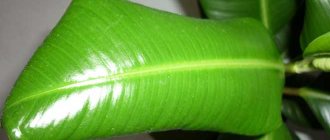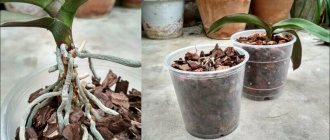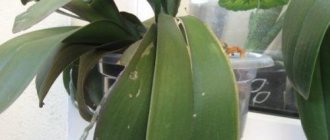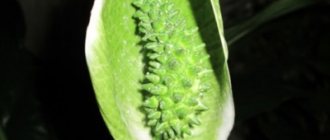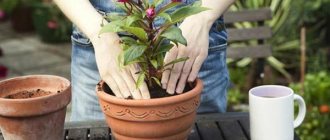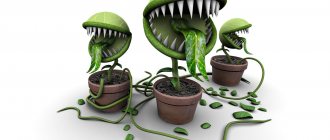| Article verified by a practicing veterinarian |
Have you ever come home and found vandalism committed against defenseless indoor plants? Have you ever woken up at night from a loud bang and the realization of an impending unplanned night cleaning? Spending on flower pots, soil, new exhibits in the home greenhouse, resentment and disappointment - is this all familiar? If you are looking for an answer to the question of how to wean a cat from eating indoor plants, then in this article you will get the most detailed answer with options for solving the problem.
Poisonous plants for cats
If a cat eats flowers, how to stop it from doing so? And is it necessary?
The fact is that some plants, or rather the substances in them, are poisonous to cats. In case of mild poisoning, the owner will have to deal with allergic reactions, rinsing the mouth, and nausea in the animal. In case of acute poisoning, urgent hospitalization of the animal and a fight for its life may be necessary.
For example, one of the most dangerous flowers are lilies of the genus Lilium Hemerocallis . The substances they contain are toxic and can cause severe kidney failure and even death.
If lilies appear in the house, keep them out of the cat's reach to save his life
Any part of a flower is dangerous, and even just a few petals can have serious health effects.
Symptoms of poisoning include severe drooling, vomiting, a sharp decrease or increase in the amount of urine, and dehydration.
Mistletoe and daffodils cause convulsions, gastrointestinal irritation, collapse, and lower blood pressure.
Autumn colchicum is one of the most dangerous plants. Causes shock, damage to internal organs, vomiting blood, suppression of bone marrow.
Poinsettias cause itching and pain in the mouth area.
There are more than 400 species of plants that are dangerous to cats. Of these, in the house or country house you can most often find:
- Azalea. Contains andromedotoxin. May cause vomiting, diarrhea, weakness, convulsions, changes in heart rhythm. In extreme cases, death.
- Alocasia. Contains insoluble calcium oxalate crystals. Poisoning is accompanied by excessive salivation, difficulty swallowing, and swelling in the mouth. In very rare cases, breathing difficulties may occur.
- Aloe. Contains saponins. Poisoning from this common plant causes diarrhea, nausea, loss of appetite, tremors and discoloration of urine.
- Belladonna\Amarilis. Your cat may come across this plant if he lives in the country. Eating flowers can cause tremors, severe abdominal pain, vomiting, diarrhea, and refusal to eat.
- Anthurium. Contains calcium oxalate crystals. They cause swelling and pain in the mouth.
- Begonia. Contains soluble calcium oxalate crystals. Eating causes excessive salivation, irritation of the oral mucosa, vomiting, burns of the oral mucosa, and swelling of the larynx. Due to swelling of the larynx, an attack of suffocation and death can occur. Gardenia. Contains genioposide. Causes gastrointestinal disorders. In case of poisoning, diarrhea and vomiting are observed.
- Geranium. Contains geraniol and linalool. May cause vomiting, diarrhea, anorexia (refusal to eat) and dermatitis.
- Hyacinth. Contains allergenic lactones, lycorine and calcium oxalate crystals. Most of the toxin is found in the bulbs. Causes dermatitis and gastrointestinal upset.
- Hydrangea. Contains cyanogenic glycosides. Causes gastrointestinal upset. The main symptoms of poisoning are vomiting and diarrhea.
- Dieffenbachia. Contains calcium oxalate crystals. Poisoning is accompanied by irritation of the oral cavity, itching, burning, excessive salivation, vomiting, decreased appetite, and difficulty swallowing.
- Dracaena. Contains saponins. In case of poisoning, dilated pupils, vomiting (with or without blood), loss of appetite, and weakness are observed.
- Calla lilies. Contains insoluble calcium oxalate crystals. The most dangerous are the bulbs. After eating, swelling and irritation in the oral cavity, excessive salivation, and vomiting occur.
- Kalanchoe. Contains glycosides and bufadienolides. Rarely causes arrhythmia. Most often, problems arise from the gastrointestinal tract. Symptoms include diarrhea, vomiting, irritation of the oral mucosa, and increased heart rate.
- Oleander. Contains cardiac glycosides. In case of poisoning, the functioning of the heart is disrupted. Symptoms include arrhythmia, changes in blood pressure, as well as gastrointestinal upset and dehydration.
- Ivy. Contains triterpene saponins. The most dangerous are the leaves. Departure is accompanied by abdominal pain and diarrhea, as well as drooling.
- Ficus. Contains ficin and ficusin. Causes disturbances in the gastrointestinal tract and skin irritation. Symptoms include rash, redness of the skin, as well as vomiting and diarrhea.
- Philodendron. Contains insoluble calcium oxalate crystals. Causes swelling in the mouth, difficulty swallowing and vomiting.
- Cyclamen. Contains cyclamine. Eating leaves and flowers causes drooling, diarrhea and vomiting. Roots are more dangerous. They can cause seizures and arrhythmia, even death.
- Euphorbia. Contains euphorbin. Provokes irritation of the gastric and oral mucosa and vomiting.
The dangers of the home garden
Indoor flowers can pose a major threat to a cat's health. The poison contained in plant sap can cause serious damage to your pet:
- cause stomach upset and cramps;
- create intestinal obstruction;
- provoke allergies;
- burn the mucous membrane;
- lead to disruption of organ function.
Cats should not eat flowers such as:
- Kalanchoe;
- violets;
- lilies;
- orchids;
- hydrangeas;
- azaleas;
- spathiphyllum;
- begonias;
- chrysanthemums;
- lilies of the valley;
- daffodils and other types of plants.
Reasons why cats destroy house plants
On the street, cats are interested in movements in the grass, because small rodents and large insects can hide there. And even though there are no pests in the house, the cat will be curious about any movement from the flower pot. Even a small draft is enough. Such interest can lead to the cat simply turning over the flower pot and breaking it.
Even if they are domesticated, cats are predators . Their diet consists of animal products. They use grass to cleanse the body of undigested food residues and replenish the body with macro and microelements.
Regardless of whether your cat is outdoors or not, he may begin to show a gastronomic interest in houseplants. Just because they smell delicious, for example.
To solve the question of how to wean a cat from eating flowers, you need to understand the catalysts.
The reasons why cats chew plants can be divided into psychological and physiological.
Psychological ones include:
- Curiosity. Cats are very curious creatures. You've probably noticed that they crawl into literally every crevice and every corner. They sniff everything carefully, and if they like the smell, they can taste it.
- Boredom. The life of a modern person rarely allows for a lot of time to communicate with loved ones, including animals. And if the cat doesn’t go out for a walk, he simply has nowhere to put his accumulated energy.
- Natural harmfulness. Animals, like people, have character traits. Unfortunately, they can also be harmful by nature.
- Revenge. Perhaps an unpleasant situation for the animal occurred earlier, which it associates with the plant.
- Perverted appetite is a symptom of gastrointestinal pathology. In this case, it is worth scheduling a visit to a veterinarian.
Physiological reasons include:
- Stomach cleansing. Blades of grass eaten by a cat irritate the gastric mucosa, thereby causing a gag reflex and emptying of the stomach contents. This happens to remove undigested food components, hairballs, and other foreign objects from the stomach.
- Lack of fiber. In nature, cats obtain fiber from their prey. If there is a lack of it, the animal may encroach on the owner’s favorite plant.
- Lack of iron or other nutrients.
Why do cats eat flowers?
Animals do not spoil home flowers to spite the owner, they are only trying to find a way out of a certain situation. Nature has taught them to take care of their health and food on their own, but since cats do not always have the opportunity to walk in a green summer garden, they seek refuge on the windowsill, among flower pots. Sometimes it ends badly. Cats eat flowers because:
- The mustache's special digestive system needs help. Unnecessary substances often enter the gastrointestinal tract. Street cats consume prey without preprocessing; all feathers and bones are sent to the stomach. And all cats are amazingly clean, but after licking, some of the fur ends up in the stomach. In order to regurgitate all the “nasties”, the pet is forced to first eat plants.
- Cats are drawn to greens and petals due to a lack of vitamins. Usually, when outdoors, pets unerringly find the herbs they need. But in a homely atmosphere the choice is negligible, and the animal, in confusion, steps over its natural knowledge to taste an unfamiliar flower.
- Some plants cure cat diseases and balance oxygen in the blood.
The cat eats flowers. How to wean it - advice from veterinarians and isopsychologists.
Option 1
You can use a spray bottle with water . But there is a possibility that after this the animal will begin to be afraid of water procedures. Therefore, this method is not suitable for everyone. A better option is an air spray bottle , this is sold in many pet stores. As an option, you can simply blow on the cat: he is unlikely to like this.
Option 2
Grow your animal a mini-garden in his eating area. In the store you can buy seeds of oats, barley, lawn grass, and catnip. To germinate them you will need a container, soil, a dark place and a little care. When the sprouts begin to sprout, the plantation can be moved to a sunny window and allowed to grow for several days. Then place it near a bowl of food.
Every time you notice that the cat wants to spoil the plant, move the offender to the place where he eats. The point of this action is for the cat to get a cause-and-effect relationship in his head: food is always in one place, you can’t eat in other places.
If purchasing and growing seeds is problematic, the pet store sells ready-made boxes with sprouted grains.
Cat psychology to help
Some owners even talk to their cats about house flowers, but, as a rule, words are in vain. Action is needed, and the sooner the better.
- All cats hate water . Buy a water gun and use it as a pet repeller. As soon as the naughty guy takes a decisive step towards the flower pot, feel free to pull the trigger. Cold, wet streams will wash over the cat, and he will soon understand that eating house flowers is chilly and unpleasant. The cat will also remember the places in the apartment where he was sprayed and will try to avoid them.
- If the owner smiles tenderly at the kitten instead of raising his voice and scolding him on the matter, the pet will quickly become a spoiled child. He will understand that for eating flowers the owner himself “blossomed” in front of the prankster. This means that you need to please a person more often with your color mania.
- You can buy a special cat repeller . The device must be placed close to the flowers. As soon as a playful cat steps towards a flower, the device will make a loud sound or splash water on the animal. There are devices that emit a smell that cats hate. This effective method has helped many owners.
Option 5
You can come up with decorative interior solutions . For example, on the inside of the windows, build a partition for pots with plants around the entire perimeter, which you can open and close.
It is not advisable to make hanging structures and shelves on the window itself, since cats love to climb into hard-to-reach places and show talent for climbing on absolutely flat surfaces. Such a decision may be perceived as a call to action.
But hanging pots are a good solution. The main thing is that they cannot be reached while jumping.
Hanging pots save you from cats
Cats don't like things rustling under their paws or fur sticking to them. Perhaps laying out foil or double-sided tape around the plant will help you. When using foil or tape, you must always remember that the animal can eat these items, which can end very badly.
Surveillance
The best solution to combat plant eaters is total surveillance. Your favorite flower to devour should be placed where you spend the most time. As soon as the toothy mouth is near the plant, you need to carefully grab it by the scruff of the neck and engage in suggestion. If the cat sits next to the flower and does not touch it, then you need to reward it with some kind of treat. Then, fairly quickly, good neighborliness will resume between the plants and the cat.
Photo-hunt for a cat devouring (spoiling) flowers
If all these methods of how to stop a cat from chewing flowers do not work. If you don’t want to part with the plants, you will have to use technical means of protection. To do this, you will need a mesh with small cells and a good frame, which will make it possible to lower the mesh during watering and spraying. This is not the easiest and most pleasant, but the most effective way. The cat will not be able to climb on such a net. And even if she does, a couple of bad falls will quickly wean her from exploring the grid.
Option 6
Create a cat land. Make a lot of secluded places, lay out boxes and containers. Cats love to hide and get into tight places. Let him direct his cognitive energy to learning new things in the house.
Whatever you choose as a measure to combat indoor pests, remember that scolding, screaming and physically punishing are not about cats. If nothing helps at all, then you need to completely isolate the plants . Take it to another room, which will be locked. Or give them to friends, because the cat’s health is always more important.
Recommendations
To consolidate the result, you need to combine several working methods. Comprehensive measures will wean the cat from eating indoor vegetation. Even if the pet has completely torn the flower apart, it is prohibited to use physical punishment.
Switch attention
The source of problems is often the hunting instincts of cats. In pursuit of prey, the animal does not notice how it knocks over a flowerpot on the floor or ruffles the foliage. First, cats carefully touch the plant with their paws, determining whether the object is dangerous. If the object is safe, then the pet begins to act.
New toys that do not resemble the object of attack will help shift the cats' attention away from flowers. To prevent the animal from destroying vegetation, daily physical activity is needed (from 15 to 40 minutes). Having fun with a mouse on a fishing rod or a candy wrapper on a rope will satisfy your hunting instincts.
Replace flowers with grass
Cats have slow peristalsis, and greens help improve digestion. Plant fibers protect against constipation, intestinal obstruction and remove hairballs (provoking a gag reflex). In case of parasitic infestations, foliage helps to mechanically get rid of worms.
More often, pets who eat dry food or have gastrointestinal diseases hunt for flowers. With an unbalanced diet and home life, vitamin deficiency occurs. By absorbing greenery, cats saturate the body with useful microelements. An indoor lawn will discourage your pet from gnawing on ornamental plants. In order not to collect grass in parks and along roads, you need to grow greens at home.
Used as a vitamin supplement:
- wheat;
- oats;
- barley.
Seeds are planted in a pot or plastic food container. The dishes are placed on a bright windowsill and watered regularly. Vegetation is cut and added to food or offered to the pet to nibble on its own. If the cat likes dry grass, then the greens are pre-dried.
Monitor your health
Veterinarians include mental changes due to trauma (medication) and obsessive behavior due to stress as dangerous problems. Animals lose the line between edible and poison and relieve stress by eating uncontrollably. Regular (every 6 months) visits to the clinic will help eliminate the risk of pathology.
You can protect ornamental crops from pets with the right approach. Before you stop your cat from eating flowers, you need to determine the cause of the problem. Consistent actions, persistence and the absence of physical punishment will help consolidate the result.


